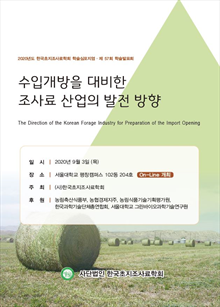간행물
한국초지조사료학회 학술대회논문집

- 발행기관 한국초지조사료학회
- 자료유형 학술대회
- 간기 연간
- 수록기간 1998 ~ 2020
- 주제분류 농수해양 > 축산학 농수해양 분류의 다른 간행물
- 십진분류KDC 527DDC 636
권호리스트/논문검색
2019년도 한국초지조사료학회-한국축산환경학회 공동심포지엄 및 제56회 학술발표회 (2019년 6월) 77건
포스터
41.
2019.06
구독 인증기관·개인회원 무료
42.
2019.06
구독 인증기관·개인회원 무료
43.
2019.06
구독 인증기관·개인회원 무료
44.
2019.06
구독 인증기관·개인회원 무료
45.
2019.06
구독 인증기관·개인회원 무료
46.
2019.06
구독 인증기관·개인회원 무료
47.
2019.06
구독 인증기관·개인회원 무료
48.
2019.06
구독 인증기관·개인회원 무료
49.
2019.06
구독 인증기관·개인회원 무료
Comparison Dry Matter Yield and Forage Quality at Seeding Time and Harvest Time in Mid-Northorn Area
50.
2019.06
구독 인증기관·개인회원 무료
51.
2019.06
구독 인증기관·개인회원 무료
T. I. Kim, M. Vijayakumar, D. H. Lim, J. H. Lee, Y. C. Baek, S. M. Kim, J. H. Park, J. H. Shin, S. M. Park, J. H. Park, E. T. Kim, D. H. Kim, H. J. Lee, H. C. Choi, K. S. Ki
52.
2019.06
구독 인증기관·개인회원 무료
53.
2019.06
구독 인증기관·개인회원 무료
Different types of lactic acid bacteriaw were isolated (LAB) from legume plants. A total of fifty LAB strains were isolated from legume plants and analysed its growth profiles in Alfalfa and crimson clove soups. Results suggested that all strains were able to grow in alfalfa and crimson clove soups. However, only seven strains were growing well and reduced the pH of the soups than the other strains. The selected strains were characterized and identified by biochemical and molecular tools. Results demonstrated that all strains belonged to the Pediococcus pentosaceus. Also, strains can produce industrially important enzymes and ferment the different carbohydrates substrates in-vitro. Overall results suggested that isolated LAB could be considered as potential strains to improve the fermentation process
54.
2019.06
구독 인증기관·개인회원 무료
In this study, we aim to evaluate the phenoilcs profile of fresh freeze dried whole crop rice (FWCR) sample by HPLC–DAD analysis. Firstly, the fresh whole crop rice (before heading stage) was dried using liquid nitrogen and then powdered sample was extracted using methanol-water. The extract was quantified phenolics and flavonoids content by HPLC-DAD. HPLC-DAD analysis showed that the FWCR contained six phenolic acids including; caffeic, p-coumaric, ferulic, and chlorogenic acid, prophyl gallate in addition to five flavonoids; rutin, vitexin, luteolin, qurecetin and kaempferol. Results indicated that ferulic and p-coumaric acids were the major soluble phenolic acids in FWCR, and their concentrations were 3.1 and 2.65 mg/g DW. It can be summarized that the presence of phenolic and flavonoids in FWCR enhance the palatability and feed intake of ruminants.
55.
2019.06
구독 인증기관·개인회원 무료
Lactic acid bacteria (LAB) were isolated and analysed its fermentation ability in triticale powder at different moisture levels. Furthermore, the antibacterial activity of fermented silage extract against cattle pathogens was also studied. The isolated strains were P. pentosaceus (TC48) and L. brevis (TC50) that confirmed based on biochemical and 16srRNA sequences methods. Extract from LAB fermented silage showed higher antibacterial activity (inhibition zone diameters: 18~24.2 mm) against E. coli P. aeruoginosa, S. aureus and E. Fecalis than the non-inoculated silage extract. TC48 and TC52 strains exhibited high tolerance to artificial gastric, duodenal and intestinal fluids. In summary, lactic acid bacteria mediated fermentation of triticale silage extract showed great antibacterial activity with significant probiotic characteristics might be an effective and safe way to provide new strategies for reducing the incidence of pathogenic bacteria associated diseases in animals.
56.
2019.06
구독 인증기관·개인회원 무료
57.
2019.06
구독 인증기관·개인회원 무료
58.
2019.06
구독 인증기관·개인회원 무료
59.
2019.06
구독 인증기관·개인회원 무료
60.
2019.06
구독 인증기관·개인회원 무료

